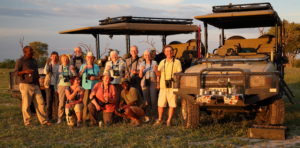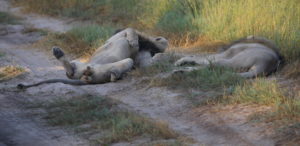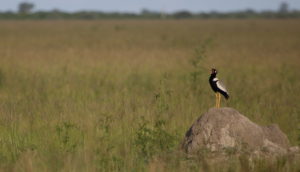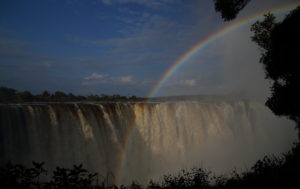The wires alongside the tar road taking us north out of Maun are lined with numerous Ring-necked Doves and beautiful Lilac-breasted Rollers and Southern Carmine Bee-eaters. Here we are again back in Botswana, almost twelve months to the day since our last visit, and yet the conditions are markedly different, as last year’s dry sandy track is now awash with wide deep turbid puddles, slowing our progress into the ‘bush’. Once inside the vast Moremi Game Reserve, we soon begin seeing plenty of game including Southern Giraffes, Burchell’s Zebra, Impala, Greater Kudu, Warthog, scurrying Tree Squirrels, a troop of Chacma Baboons, Cape Buffalo, carrying Yellow-billed Oxpeckers, and ‘well hung’ bull Elephants. By now we are well off the beaten track, as the ever-narrowing ‘road’ becomes a barely perceptible pair of tyre tracks, and often flooded, as we head deeper into the famous Okavango Delta. Along the way numerous bird sightings include Red-billed Teal, Red-billed and Swainson’s Spurfowls, Fork-tailed Drongo, stunningly iridescent green, blue, indigo and violet Burchell’s Starlings and four different Bee-eaters; Southern Carmine, Little, Swallow-tailed and European. Retiring to our tents after dinner, the camp is surrounded by the cacophonous chorus of a ‘million’ pinging and tinkling Painted Reed Frogs, the deep bellowing of Hippos and the occasional roar of a distant Lion.
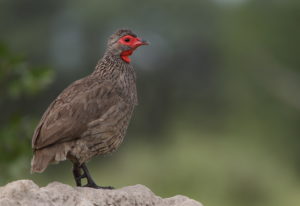
This morning, as the jeeps emerge from the wooded camp, we realise just how close the Hippos are, and their pan is also teeming with birdlife; Spur-winged and Egyptian Geese, White-faced Whistling Duck, Squacco, Striated and Goliath Herons, Dwarf Bittern, Great White Egret, African Darter, African Jacana, Black-winged Stilt, Common and Wood Sandpipers, Long-toed and Blacksmith Lapwings, White-winged and Whiskered Terns, Pied Kingfisher, Grey Go-away Bird, Red-eyed Dove, Rattling Cisticola and Magpie Shrike. Moving on to the next of many pans we find more Hippos as well as African Fish Eagle, African Sacred Ibis, Yellow-billed and Knob-billed Ducks, Pink-backed Pelican, Water Thick-knee and Wattled Cranes, with a couple of Black-backed Jackals relaxing on a patch of dry sand. A radio report of a not too distant Cheetah attracts our attention and by 8.25am, after a good deal of searching, we get a brief but full length view of the shy sleek feline before it melts away into the scrub. Moving on again, new sightings include Hamerkop, African Palm Swift, Wattled Starling and Common Reedbuck, while the next pan is stuffed with African Spoonbills, Yellow-billed Storks, Hottentot Teal, Yellow-billed Duck and an African Skimmer. Meanwhile, a congregation of White-backed Vultures, presumably attracted by the leftovers from a Lion kill, also produces a White-headed Vulture and a Tawny Eagle, with a bulging crop, in the same tree as a 4 foot long Monitor Lizard! The next new sightings are Laughing Dove, a pair of preening Ostriches and a Three-banded Plover, while a pair of close Yellow-billed Storks, obligingly demonstrate their feeding technique, which involves dipping their open bills into the water, while stirring the silty bottom with their long pink legs. After a welcome tea break beside a pool alive with Hippos and waterbirds, including a flock of a dozen or so Ruff, we add Cattle Egret, Dickinson’s Kestrel, Grey and Black Herons, African Harrier-Hawk and Tsessebe antelope to an impressive list for a morning’s ‘work’.
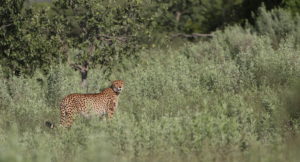
This afternoon we begin with a comparison of the truly black Black Heron, with a nearby definitely dark grey Slaty Egret, which is endemic to this part of Africa, whereupon a white-rumped Gabar Goshawk flashes by, like a Sparrowhawk would back home. The first of many Red-backed Shrikes is the next new sighting, followed by a very smart male African Pygmy Goose, a bleating Grey-backed Camaroptera, a family group of three Southern Ground Hornbills, some nest building Red-billed Buffalo Weavers, a pair of Purple Rollers, a soaring Martial Eagle, and both Yellow-billed and African Grey Hornbills, making four different hornbills in one day. New sightings continue with Grey-headed Kingfisher, Brown Snake Eagle and a group of Woolly-necked Storks, flying to roost in a dead tree, while a Black-crowned Night Heron is still snoozing in its day time roost. Red-eyed Bulbul is last tick of the day and then it’s back to camp for a delicious steak dinner and another frog chorus.
The daily routine begins at 5.30am with a friendly “Knock knock” wakeup call from the camp crew, bringing warm water to the tents for a wash, before breakfast at six. Setting off in the jeep just before seven, we begin with our familiar Spotted Flycatcher and Willow Warbler, and a far more exotic Black-backed Puffback, before even leaving camp. Soon after we also find Hartlaub’s Babbler, Levaillant’s Cuckoo and our first party of Helmeted Guineafowl, dashing around like demented chickens. New sightings continue with Marico Flycatcher, Crested Barbet, Arrow-marked Babbler and the amazing Long-tailed Paradise Whydah. A band of around ten busy Banded Mongooses crosses our path, but their show is overshadowed by a couple of amorous Chacma Baboons, at it ‘like rabbits’! The courting couple’s privacy is soon shattered by other members of the troop, from babies to grownups, arriving in droves, with a final count of around eighty! Around twenty action packed minutes fly by as the Baboons go about their usual antics; foraging, climbing trees, splashing around in the water, mating, grooming, quarrelling and wrestling, while two rutting male Impalas stage a side show, like a scene from a BBC wildlife documentary.
By mid morning, around 9am, it’s time for ‘elevenses’ with the Hippos and pelicans, and then it’s back to ‘work’ with sightings of a pair of Woodland Kingfishers, a female Bennett’s Woodpecker, two magnificent Wattled Cranes, at relatively close range, Crested Francolins on the track, a return of the Banded Mongooses and a gaudy Crimson-breasted Shrike calling from a nearby bush. Heading back to camp, we encounter a group of resting Blue Wildebeest, a trio of White-browed Sparrow-Weavers building one nest, an imposing Tawny Eagle posing on the top of a dead tree, a confiding Emerald-spotted Wood Dove and a Giraffe ‘roadblock’! We’re welcomed back at camp with whistles, whooping, cold drinks and refreshing moist towels, in time for lunch at noon, followed by some free time to take a shower from a bucket and then relax around the camp, which is alive with the chattering of Burchell’s Starlings, along with African Paradise Flycatcher and Swamp Boubou.
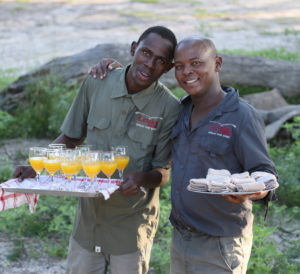
After tea and cake at 3.30pm, the safari restarts around four with Blue-cheeked Bee-eater, our fifth bee-eater species of the trip, as well as a pair of Bennett’s Woodpeckers, another Grey Go-away Bird and a Chirping Cisiticola. Moving on we find a Dwarf Mongoose playing ‘peepo’ behind a fallen log, and then another Pygmy Goose, not much bigger than a nearby Little Grebe! Minutes later, a Scimitarbill shows up with an incredibly fine curved bill. Meanwhile, a pair of Woodland Kingfishers stage a fabulous show by displaying to each other with fully fanned out wings in a spread eagle posture. A male Pin-tailed Whydah also shows off with a dipping flight display, and then it’s the turn of a Zitting Cisticola with its bouncing “zit zit” song flight. Our route leads to a very rich and scenic wetland, home to a herd of at least thirty smart Red Lechwe, an antelope which can only be seen in this part of Botswana! The wetland also teems with the usual waterbirds, including the awesome Goliath Heron, as well as Reed Cormorant and Rufous-bellied Heron, which are both new for the trip. Also new is a pair of enormous Verreaux’s Eagle-Owls, roosting below the canopy of a tall tree, while looking down on us with their large dark sleepy eyes. A trio of Hooded Vultures roosting in a tall palm is another new bird for the day, and after a lovely sunset at around 6.42pm, there’s still time to find our first Nile Crocodile, albeit a tiny one, on the way back to camp for a drink around the camp fire and a log of the day’s sightings before dinner at seven, when our knowledgeable and ever alert guide Gee tells us that “the Lions are on their way”! That’s another typical day on safari in Botswana.
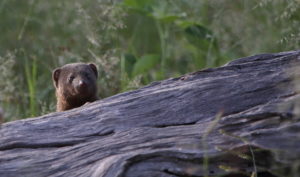
It’s time to leave camp 13 for the last time and move on to our next site at Xakanaxa, but the unusually high water levels mean a hair raising drive through water as high as the radiator grills of the currently amphibious Landcruisers. These amazing all terrain vehicles can go almost anywhere. As they create a surging wash through the watery landscape, Red Lechwe paddle away, occasionally leaping gracefully clear of the water as they go. With spring approaching in Europe, our very own Barn Swallows are gathering in large flocks in readiness for their long journey north.
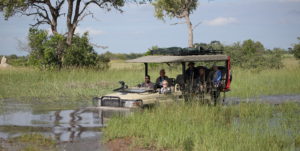
At 7.48am, just as Gee promised, we find the Lions which were roaring last night, with one of the four young males sprawled across the sandy track, while his three brothers are all equally prostrate within a few yards of each other. They look as if they have had a hard night, busy roaring and maybe hunting, as the best they can do now is an occasional yawn and a lick of their huge padded paws. After half an hour, the two Lions nearest to the track decide to move into the shade of a nearby bush and so we move on for more wildlife spectacles, including a pair of African Hawk-Eagles, an African Golden Oriole bashing a large grub against a Mopane branch and a White-browed Scrub Robin singing from the top of a bush.
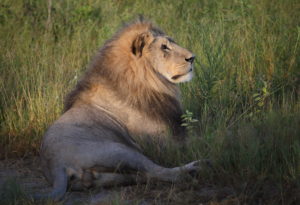
After a tea break back at the Hippo and pelican pan, we’re back on the ‘road’ and soon have to give way to a family of seven Elephants, of various ages, some crossing in front of the jeep, while others pass just behind us, leaving their wrinkled ‘dinner plate’ footprints in the soft sandy surface of the track. Passing the ‘Monitor Lizard’ tree, the large reptile is still lying in the same fork as it was two days ago, whereupon the Tawny Eagle flies in and lands on a branch to pose for us again. Moving on through open grassland, Carmine Bee-eaters swoop and hover alongside, and even in front of the jeep, providing a challenge for the photographers, while others simply enjoy the spectacle of these graceful and colourful birds at such close range. Beyond the rickety makeshift Second Bridge, new birds include Greater Blue-eared Starling, Red-billed Oxpeckers riding on the backs of Zebras, a gorgeous Broad-billed Roller, a posing Red-necked Falcon and a passing flock of Collared Pratincoles. The shade from a massive Sausage Tree is an apt site for a picnic lunch, in the company of very tame Burchell’s Starlings, as well as Ashy Flycatcher, African Paradise Flycatcher, Bennett’s Woodpecker, Long-billed Crombec, Green Woodhoopoe, Levaillant’s Cuckoo, noisy Hartlaub’s Babblers and a Red-billed Hornbill intent on stabbing its own reflection in the jeep’s windscreen!
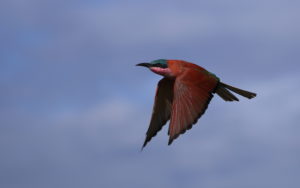
After lunch new sightings continue with Namaqua Dove, Jacobin Cuckoo, loads of Grey-rumped Swallows, a Saddle-billed Stork, with an impressive bill ‘painted’ red, black and yellow, and a Marico Sunbird with a gleaming golden head. It’s almost five o’clock as we reach Fourth Bridge, where the tall reeds produce Fan-tailed Widowbird, as well as local specialities like Coppery-tailed Coucal and Luapula Cisticola, followed by the endemic Slaty Egret fishing successfully for tiddlers in a mirror-calm pool. Further on we enter tranquil Mopane woodlands, inhabited by Swallow-tailed Bee-eaters, African Hoopoe, Black-crowned Tchagra and Arnot’s Chat. Journey’s end is Camp 9 in an open stand of tall Mopane trees, in time for a shower and then a relaxing drink around the campfire, listening to the sounds of the African ‘bush’ as the evening sky reddens in the west.
Today’s wakeup call is courtesy of not so distant Lions roaring before sunrise, which may explain the statuesque stance of a group of nearby Giraffes at breakfast time (6am). We leave camp at 6.45am to take a boat ride at 8am, which is a thirty minute to one hour drive from camp, depending on how much we see along the way. Fresh Lion prints in the sandy track show just how close they were to camp last night, but heading in the opposite direction to the boat launch. Along the way we find Striped Kingfisher, Vervet Monkeys and an alert Pearl-spotted Owlet posing in the early morning light. Pausing to admire a nearby Waterbuck, Penny looks back saying something like “There’s a spotty animal there”. I instantly realise it’s a Leopard sitting in the long grass, merely 20 yards from the track! How lucky is that? After posing for a few shots, the cat flops into a snoozing position, giving us time to catch our boat. At the boat launch, we are joined by Broad-billed Roller, Dark-capped Bulbul, another gleaming gold Marico Sunbird and a pair of nest building Lesser-striped Swallows, which are new for the trip.
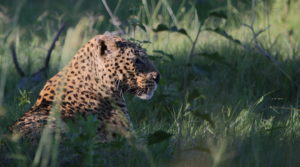
Cruising peacefully upstream along the tranquil clear channels of the Khwai River at about 5 miles per hour, numerous really cute African Pygmy Geese prove camera shy, while a Hippo repeatedly porpoising along the channel ahead of us provides lots of action footage. Besides the Chirping Cisticola, we soon realise that the commonest bird here seems to be the African Stonechat, which seems odd in such large expanses of tall reeds, as does a hovering Black-winged Kite. The main target here is the rare Lesser Jacana, daintily trotting with ease across the vegetation emerging from the water, as it is such a lightweight bird. Other new sightings include White-backed Ducks, Little Bittern, Black Crake, African Swamphen, Malachite Kingfisher, Cape Wagtail, Cuckoo-Finch, so called because it parasitises the nests of prinias and cisticolas, and the African Openbill, a blackish stork with daylight showing through its closed mandibles. On the return journey, we startle a large Nile Crocodile, and by 3pm the Night Water Lilies are opening to reveal their large lemon yellow blooms, alongside the day flowering white lilies, suffused with a delicate violet hue.
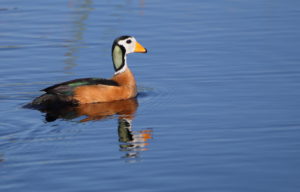
On the drive back to camp, Black-collared Barbet is new for the trip, the old Leopard pads along the track ahead, and we find another Saddle-billed Stork, and then a ‘lively’ tree containing Ring-necked Dove, Black-backed Puffback, Southern Black Tit, Dark-capped Bulbul, a pair of Brubrus and a female Cardinal Woodpecker. Last stop is for a very obliging immature Bateleur, perched right beside the track.
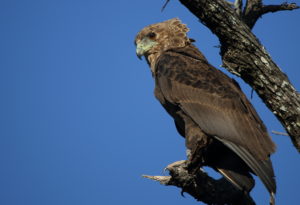
Today dawns with two Spotted Hyenas lurking in the half light barely 100 yards from the breakfast table! The morning game drive begins in the Mopane woods with the usual suspects like African Hoopoe and Arnot’s Chat, plus Icterine Warbler, which is a ‘new’ bird, and better views of African Green Pigeon. Moving on we admire the corkscrew horns of an impressive bull Kudu, marvel at the strange bellowing song of a puffed up White-browed Coucal and watch a pair of Hamerkops building their enormous nest, which is a six month project! Crossing an open grassy area, we are again entertained by aerobatic Carmine Bee-eaters, swooping after insects disturbed by the jeep, while the monkey business of a group of playful Vervets, leaping over one another on a branch like circus performers, is equally entertaining. After morning coffee by a pan with lots of Hippos and Cattle Egrets, we watch the activity at a colony of Village Weavers, where the handsome males are busy weaving fresh green blades of grass into their new nests, or hanging from them with flapping wings in an effort to attract the females, which are sat chattering in a nearby bush! A white-tailed Side-striped Jackal is a new mammal and a little further on we find a roving band of about twenty vociferous White-crested Helmetshrikes.
This afternoon is the hottest so far with a cloudless blue sky, which matches the colour of the balls of the male Vervet Monkeys we find this afternoon, along with mothers and tiny babies. Next we meet a troop of Baboons, again with youngsters and an alpha male mating with and then being groomed by a red-bottomed female. This area of beautiful Mopane woodland has particularly bad tracks with deep muddy ruts and pools, making a challenging course, even for the almighty Landcruisers, but the white knuckle ride, with bottoms regularly leaving their seats on the bumps, is rewarded with stunning views of African Green Pigeon and Meyer’s Parrot in perfect late afternoon light. Then it’s back to camp for a well earned G & T around the campfire. Venus shines bright this evening despite the full moon, Orion is horizontal and the Southern Cross is also visible.
This morning, we break camp and head northeast, fending off low branches in one of many areas of low but dense Mopane trees. Once the trees open out we spot a very smart Shikra, like a small Sparrowhawk, posing in the morning sunshine. At the Xakanaxa gate, a comfort stop produces long-eared Bats hanging from the thatched ceiling. Continuing along a very bumpy muddy track, tipping the sliding jeeps into various rakish angles, a Slender Mongoose crosses the track and we add Bradfield’s Hornbill to the ever growing trip list. Right on schedule, just before noon, we arrive at North Gate and find a pair of Barn Owls roosting in the thatched roof above the gate. Leaving the vast wilderness of the Moremi Game Reserve, across the bridge over the River Khwai, it feels strange to be back in human habitation, although Bokakwhe village is little more than a cluster of mainly thatched huts and a couple of tuck shops, and then we’re soon back in the bush. After another delicious picnic lunch beside the Khwai River, we follow its course into the Khwai Community Reserve, where we soon find lots of Red Lechwes as well as Intermediate Egret and a pair of dancing Saddle-billed Storks. Other sightings this afternoon include more Bennett’s Woodpeckers, plus Southern White-crowned Shrike and African Crake. Journey’s end is a lovely camp beside the tranquil Mbudi (Honey Badger) channel, brimful with blooming white water lilies.
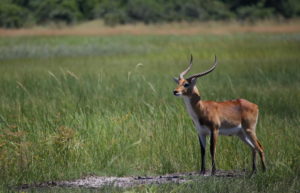
There’s a full moon and a big red sun on opposite sides of the sky at day break this morning. After a leisurely stroll to the channel, we meet a group of local boatmen and women. Being punted along a quiet backwater in a narrow flat bottomed boat, known locally as a Mokoro, allows a frog’s eye view of all the water lilies, and birds like African Jacana, Little Bee-eater, Woodland Kingfisher, Osprey, Pygmy Geese and more Openbills. Whereas bouncing along a sandy track in the Landcruiser is like riding a galloping camel, drifting slowly along the calm waterways in a Mokoro, with reed stems gently stroking one’s arms, is very relaxing, allowing laid back birding, with a tendency to lull one to sleep.

After a long leisurely afternoon back at camp, it’s time to hit the road again, with no knowing what we might see. First sighting is an African Cuckoo, with a bright yellow base to the bill and a diagnostic banded undertail, whereas ‘our’ Cuckoo has a spotted undertail. This is followed by a male Golden-tailed Woodpecker, with a completely red cap and streaky underparts, and then an African Harrier-Hawk, an unusual raptor with a bare yellow face, being harassed by a posse of starlings and drongos. Moving on, we find a Kudu crèche with three mothers and their calves and then a pair of Coppery-tailed Coucals, mating in the top of a dead tree beside the Khwai river. Whatever next? Driving along the river bank, the jeep makes a sudden emergency stop, just twenty yards short of a male Leopard sitting on the river bank and looking intently at the water! He barely gives us a sideways glance as we stare in wonder at this magnificent creature for over ten minutes. Just as the second jeep arrives, he looks behind and pads across the track into a thicket, before emerging again further along the river for another amazing view, as he reclines with an occasional wide open yawn, before slinking away into the bushes. Wow! How lucky was that? Further along the riverside track, we spot an African Crake, with a boldly barred belly, and pass a Hippo working like a farm muck spreader, thanks to its quickly rotating tail! After an action packed afternoon, it’s time for sundowners, looking west across a lagoon with feeding Yellow-billed Storks and a Hippo emerging to graze through the night.
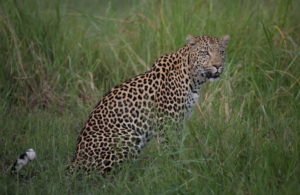
This morning, our jeeps follow fresh Lion prints along the track, but the lions remain hidden. However, we do find four lovely Meyer’s Parrots squawking in a tree, a bull Elephant quietly feeding at close range, and a Verreaux’s Eagle-Owl, trying to get some sleep below the dense canopy of a large tree, despite a noisy band of Southern White-crowned Shrikes. Other sightings here include Yellow-throated Petronia and a chattering group of head-bobbing, tail-wagging Green Woodhoopoes. The mid morning tea break beside the river produces Lesser-striped Swallow, Little Bee-eater, Coppery-tailed Coucal, a couple of large Crocodiles and an immature Allen’s Gallinule, which is new for the trip. Returning along the river we count seven Magpie Shrikes in one tree and three African Jacana chicks with one parent, as well as countless Hippos, while Amur Falcon, Ovambo Sparrowhawk and Village Indigobird (the white-billed okavangoensis subspecies) are all new for the trip.
The afternoon game drive begins with plum views of a pair of African Hawk-Eagles perched on a tree top, and five minutes later, a pair of Wahlberg’s Eagles, watching the ground from their perches. The eagles are not popular with the neighbours and a drongo even dives at one of them and repeatedly pecks its head! The eagle then swoops to the ground, causing a real kerfuffle among the starlings, drongos and hornbills, as they flock to the adjacent bushes to mob the eagle, which then flies away, with a feisty drongo ‘on its tail’, actually pecking its back! What a remarkable performance. Moving on, a Dwarf Mongoose poses on a dead tree stump and by the time we reach the hyena den there are already two mothers relaxing with five cubs from three different seasons. Over the next 45 minutes another four hyenas arrive and the family goes about its private life, suckling, playing and snoozing. Moving on again, we find a Red-billed Hornbill feeding a well developed fledgling and then find a nice spot for another sundowner, while scoping a pair of Verreaux’s Eagle-Owls stirring from their daytime roost in readiness for the ‘night shift’. As the huge owl takes flight and glides effortlessly across the clearing, one wouldn’t want to be one of the Scrub Hares which we spot on the drive back to camp, along with Square-tailed Nightjar, with lightning flashing through the distant cloudy night sky, which continues through dinner. During the main course (beef casserole) a firefly lands on the edge of Doreen’s plate, and a close examination shows that they are actually green beetles.
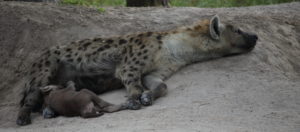
It’s time to leave Mbudi camp and so during breakfast, we watch the camp crew invent a new sport; mattress flinging, and we cheer each time another one gets flung up onto the 15 foot high roof of their truck, where a team mate waits to catch each one. We begin our journey north with a visit to an area frequented by Wild Dogs and by 7.20am, we have three of these magnificently lean dogs very close to the jeep, until they disappear into thick bushes. After a circuitous route, our head driver Gee relocates the pack on the riverside track, giving us almost half an hour of super close views of these rare predators. Each one is ‘painted’ with a unique marbled pattern of gold, brown, black and white blotches, with a white tipped tail; definitely another highlight of a wonderful safari, followed by close views of a Banded Mongoose posing on a fallen tree trunk.
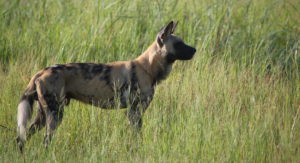
Continuing our journey north past a “Welcome to Chobe National Park” sign, Elephants cross the ‘highway’ ahead, before disappearing quietly into the bush, like a herd of Elephants does. By late morning the vast Mababe depression, a relict lake, dotted with hundreds of Wildebeest and Zebra, along with statuesque Giraffes, stretches away to the distant horizon. New sightings here include Crowned Lapwing, Red-capped Lark, African Pipit, Yellow Wagtail and the spectacular Kori Bustard, while a small wetland in the flat plain is alive with Kittlitz’s Plovers, plus Knob-billed Ducks, Blacksmith Lapwings, Black-winged Stilts, Slaty Egrets, a Rufous-bellied Heron, a Little Stint and about fifty Collared Pratincoles. Returning from the marsh, a pale grey raptor sitting on a stump requires a closer look. It’s a superb male Montagu’s Harrier, but as we drive closer, the almighty Landcruiser, is literally bogged down, deep in the hidden mire of soft waterlogged ground. With no roadside assistance for hundreds of miles, it’s down to our second jeep to tow us clear of the deep ‘brown stuff’, which is a ‘piece of cake’. Once mobile again, a second lagoon, accessible from a firm track, is lined by up to a thousand Cattle Egrets, the largest concentration I have ever seen, as well as Sacred Ibises, Abdim’s and Saddle-billed Storks and three Black-headed Herons, while a flock of about fifty European Bee-eaters heads northwards. It’s incredible to think that within about three weeks, so many of these visitors from Europe will be back in their breeding grounds, after travelling thousands of miles! The next remarkable thing is an awesome single file procession of fourteen stately Giraffes on a ‘journey’ to a distant wooded area, as the grassy plain provides protection from predators but no food. Moving on again, we find a group of thirteen Ostriches, and after numerous Zebra crossings, including many with 10 week old foals, we stop for a picnic lunch, accompanied by inquisitive Yellow-billed Hornbills. During lunch, we watch several Amur Falcons hunting over the plain, and a couple of rare, handsomely ‘face-painted’ Roan antelope, while a raucous croaking Northern Black Korhaan remains hidden in the long grass.
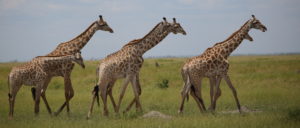
This afternoon, the long undulating sandy track leads to Savuti, where the ‘parkland’ savanna is reminiscent of what Extremadura might have been like prior to agricultural ‘improvements’. This would explain our sightings here of European Rollers, Bee-eaters and Eurasian Golden Orioles, while more exotic sightings include Black-crowned Tchagra, Red-billed Quelea, Red-crested Korhaan, Golden-brested Bunting, Southern Pied Babbler, Burchell’s Sandgrouse and giant millipedes, as long as the width of the Landcruiser tyre tracks! By late afternoon, we see rolling hills and rocky outcrops for the first time, as a break to the normally ‘big sky’ horizon. An old termite mound riddled with ‘mouse holes’ is home to at least a dozen lively Dwarf Mongooses, while a single Yellow Mongoose darting across the track is new for the trip. After a long but productive day on the road, our new address is Chobe National Park Camp 21.
It’s a new day in a new place and there is always a sense of anticipation each time we set off on a morning game drive, as one never knows what might happen. Today, barely 5 minutes from camp, we find two male Lions splayed across the track on their backs, like victims from a road accident, with a third brother resting nearby in the long grass. This Lion ‘activity’ continues until one of the males gets up and walks away, leaving us free to move on in search of more ‘action’. On a nearby rock face the crude red clay outlines of Elephant and Eland and Sable antelopes have survived the elements indelibly for around two thousand years, while the trees around the paintings produce African Golden Oriole, Little Sparrowhawk, Cinnamon-breasted Bunting, a singing Willow Warbler and stunning scope views of a Black-winged Kite, with ruby-like eyes and black ‘eye shadow’. This morning’s tea break beside a massive Baobab tree is worth a group photo, while a Great Spotted Cuckoo flies by with several Burchell’s Starlings in pursuit, and a Red-billed Hornbill is busy breaking the seal to his nest to free his growing family from inside the tree hole.
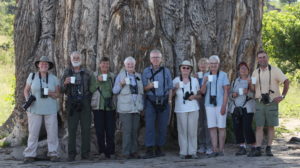
Moving on to yet another wetland, we find a flock of about one hundred Ruff, about forty Woolly-necked Storks, around a dozen African Spoonbills, a few Knob-billed Ducks, three Hottentot Teal, two Red-billed Teal, two Hamerkops and two elegant Black-winged Stilts. Penny also spots a graceful Marsh Sandpiper, and when joined by a Greenshank we get a super comparison of the sizes and shapes of these two similar species, with the sandpiper looking like a scaled down more graceful version of the Greenshank. Cape Glossy Starling is the last new bird of the morning, and then it’s back to camp 21 for lunch and a refreshing open air shower.
This afternoon we head for the Savuti Marsh. On the way a particularly ‘musty’ bull Elephant, leaking urine like a bucket shower, makes a trumpeting charge at Gee’s jeep, with ears flapping, and as Gee takes evasive action, the Elephant chases the jeep along the track! After the getaway, we find the first of many stately Kori Bustards, a very obliging African Pipit posing on a trackside stump, and a patrolling male Montagu’s Harrier, while a Gabar Goshawk flashes by. Meanwhile, a rainbow arcs from the distant horizon across 90 degrees of big sky. This vast grassy plain, dotted with a few low bushes also produces two male Lesser Kestrels, an aerobatic male Amur Falcon, catching locusts in mid air, and singing Red-naped Larks. Northern Black Korhaan is our main target here and eventually we find a male, looking magnificent as he croaks away from the top of a termite mound. Suddenly he takes off, still croaking, gains height in a circular flight and then parachutes into the grass near his mound. What a marvellous performance. Moving on, a group of seven strutting Ostriches, fan themselves with their plumed ‘wings’, like old time music hall dancers. The Carmine Bee-eaters here have learned the trick of riding on the backs of Kori Bustards, which disturb insects as they go, just as depicted on the cover of the Birds of Botswana fieldguide. Our next find is a massive Giant Bullfrog, the size of a dinner plate, which is sometimes where these meaty creatures end up! We conclude an exciting afternoon at a waterhole, teeming with Little Stints, White-winged Terns, vocal White-faced Whistling Ducks and around two hundred Collared Pratincoles.
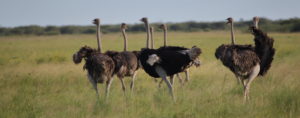
To allow for the slow road conditions, we break camp and continue our journey north half an hour earlier than normal, spotting Southern Pied Babbler at 6.13am, followed by a Little Grebe on its nest and a pair of wing quivering Scaly-feathered Weavers. Another waterhole provides close views of the usual suspects, such as Yellow-billed Storks, plus a Glossy Ibis, with Southern Masked Weavers nesting in a bush overhanging the water. Amongst all the fast moving ‘clockwork’ Kittlitz’s Plovers, we find a Three-banded Plover and a clean looking White-fronted Plover. On the long, straight and narrow bouncy sandy track heading north we pass a couple of bounding Black-backed Jackals, a female Amur Falcon sitting atop a dead tree, a couple of male Shaft-tailed Whydahs, with amazing long splayed tails, a dainty little Steenbok, a group of seventeen Roan antelope grazing on a plain stretching away from the wooded Ghoha Hills and a group of Elephants having a few pints at a pond, with a little Dumbo still trying to master the use of its funny looking trunk.
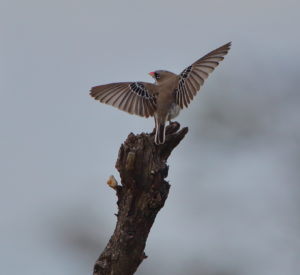
Leaving wonderful Savuti, the light sandy track becomes deep red, and lined with pink-flowering Zambezi Teaks, where heavyweight Dung Beetles make light work of making, moving and burying golf ball sized pellets of Elephant dung, for their offspring to hatch from. After so many miles of narrow sandy tracks through the bush over the last ten days, it feels strange to be back in ‘civilisation’, as we pass through a string of remote thatched hut villages (Kachikau, Kavimba and Mabele) with free range cattle, on a smooth tar road with saloon cars, power lines and road signs, including one warning of Elephants crossing!
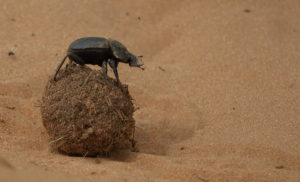
After yet another excellent picnic lunch at the Ngoma gate, we re-enter Chobe National Park and revert to rough sandy tracks overlooking the wide green floodplain of the meandering Chobe River, which forms the border with the Caprivi Strip of Namibia, barely one hundred yards away in places. Our first sighting is a Swamp Boubou and then plenty of Cape Glossy Starlings. The density and variety of game here is astonishing, with hundreds of Zebra and Impala, plus dozens and dozens of Elephants, Buffalos, Giraffes and Baboons, as well as Waterbuck, Kudu, Warthog and a group of really handsomely patterned black and tan Sable antelope (my favourite). Many of the animals give rides to either Red- or Yellow-billed Oxpeckers, while other notable sightings include Fiscal Shrike, Osprey, Levaillant’s Cuckoo, the incredible Long-tailed Paradise Whydah, six Southern Ground Hornbills in the same tree, numerous African Fish Eagles, a flock of Glossy Ibises, several Lesser Kestrels busily catching locusts over the floodplain, and a large trundling Leopard Tortoise. Our new address is Chobe National Park Camp 8, but without any signs, or a postcode, it takes a bit of finding!
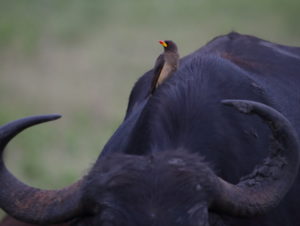
This morning’s game drive begins with another grumpy bull Elephant blocking the track, and so we have to wait until he moves off into the bush, so that we can speed by, rather like waiting at roadwork traffic lights on red, followed by a sudden dash on green before they change again. Bird sightings come thick and fast with African Golden Oriole, Violet-backed and Wattled Starlings, both Black- and Brown-crowned Tchagras, Blue Waxbill, Red-billed Firefinch, Arrow-marked Babbler, Great Spotted Cuckoo, a group of five impressive red-faced Southern Ground Hornbills stalking the long grass, a couple of flamboyant male Broad-tailed Paradise Whydahs, a Dark-capped Bulbul feeding a Jacobin Cuckoo, plenty of European and Southern Carmine Bee-eaters and the remarkable dipping flight display of a Long-tailed Paradise Whydah. After a busy morning we take a break for tea and coffee under the shade of trees at the edge of the floodplain, while watching the scene beyond, where around 750 Zebras are grazing, while flocks of Glossy Ibises and Grey-headed Gulls fly by and a White-headed Vulture waits patiently for any leftovers from a pair of African Fish Eagles. Back on track, the air is full of thermaling Lesser Kestrels and Amur Falcons, and we spot Red-faced Mousebirds in a trackside bush and “Crocodiles in Namibia”! On the way back to camp a driver going the other way tells of “some birds on a Zebra”. Speculating on whether they might be Red- or Yellow-billed Oxpeckers we go to investigate, only to find that the birds are actually White-backed Vultures, crawling all over a complete Zebra carcass, minus the exposed eye, which was the first entry point for the vultures. Such raw nature can be gross but also engrossing, and as we watch the melee of vultures squabbling all over and around the body, several birds deep, a constant stream of new arrivals pile in from the sky on awesome 6 to 7 foot wingspans! By now there must be at least a hundred, with more arriving every minute, and a normally nocturnal Scrub Hare, spooked by so many large birds descending, dashes past the jeeps at breakneck speed. Ironically, it’s now time for us to head back for lunch, with more playful Baboon action along the way.
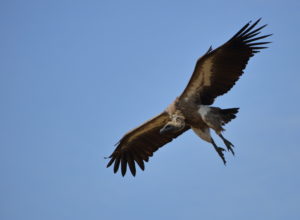
The after lunch shower provides considerable amazement with the discovery in one of the ‘cubicles’ of a humungous flightless cricket, as long and fat as a man’s finger! To keep up with the Jones’s the neighbours contribute to the impromptu ‘bug show’ with a brilliant emerald green beetle and a 5 inch long stick insect! This afternoon’s game drive begins with a mother Buffalo with a very young calf, followed by brief views of a pair of rare Bat-eared Foxes, more Baboon antics and a herd of around one thousand Buffalo, busy chewing the cud. Back at the Zebra carcass, a Lappet-faced Vulture sits patiently on a dead tree top, watching a tense standoff between three Black-backed Jackals and at least sixty-odd vultures, with the jackals holding back and even biting the vultures, until they slope off, allowing the vultures to close in and engulf the body once more, four birds deep. Back at camp, we enjoy our last excellent bush dinner, followed by a Beautiful Africa sing song, while the evening symphony of stridulating insects plays again.
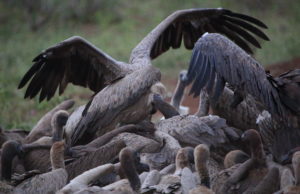
It’s sadly time to say a big thank you and farewell to the amazing camp crew, who looked after us so well throughout our safari, with supplies of warm water, cool drinks and excellent meals. Leaving Chobe National Park, we add Marabou Stork to the bird list, with a group of about forty clustered around a small pool, followed by another Barn Owl, roosting above the Sedudu gate. By now we had covered hundreds of miles, on narrow unmarked tracks, without the need for a map, thanks to Gee’s and CJ’s phenomenal familiarity with the region, in addition to their amazing tracking and spotting skills, giving us a spectacular and unforgettable journey.
Back on the tar road, we follow signs for Kasane, a small border town, with dozens of Baboons and Banded Mongooses in the high street! Soon after boarding our private cruise on the Chobe River, White-crowned Lapwing, Brown-hooded Kingfisher and Wire-tailed Swallow at close range are all new for the trip. By cruising slowly along, the wildlife accepts such a small boat at close range, producing super views of a variety of birds like African Sacred Ibis, Darter, Jacana and Spoonbill, Reed Cormorant, Long-toed, Blacksmith and African Wattled Lapwings, Water Thick-knee, Pied and Grey-headed Kingfishers, African Pied and Cape Wagtails, the Black Heron, which hunts in an umbrella stance, the obligatory African Fish Eagle, and a wheezing Southern Red Bishop, chasing females while puffed up like a woolly pom-pom. The Crocodiles and Water Monitors sunbathing on the river bank are equally confiding, allowing snaps from as little as six feet! Back on dry land, we head for the nearby border crossing into Zimbabwe, and the sumptuous luxury of Ilala lodge in Victoria Falls, within earshot of the ‘smoke that thunders’.
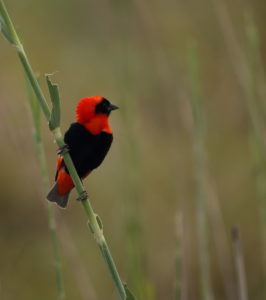
After a leisurely breakfast, we explore the grounds around the lodge, where garden birds include old acquaintances like Laughing Dove, Senegal Coucal, African Palm Swift, Black-collared Barbet, Dark-capped Bulbul, Red-faced Mousebird, Grey Go-away Bird, Southern Black Tit, Black-backed Puffback, Tawny-flanked Prinia, White-browed Scrub Robin, Blue Waxbill, White-browed Sparrow-Weaver and Village Weaver, as well as new birds like Speckled Pigeon, Brown-throated Martin, Collared Palm Thrush, Red-winged Starling, Pied Crow, Northern Grey-headed Sparrow and tiny Bronze Mannikins.
This afternoon we take a short stroll to the world famous Victoria Falls, one of the seven natural wonders of the world, where the mighty Zambezi plunges 354 feet into a mile wide gorge, with a continuous thundering roar, throwing clouds of spray sky high and creating spectacular rainbows. The fallout from the spray creates a rainforest micro-climate home for large exotic butterflies in a range of colours, as well as a welcome cool shower for visitors. Alongside the awesome white water cataracts, we meet confiding white-spotted Chobe Bushbuck and a group of Thick-billed Weavers, while a chevron of around sixty Sacred Ibises flies over the falls on their way to roost. Where better to end such an amazing journey?

